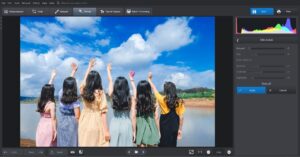Image editing is an important part of many creative projects, from website design to photography. For beginners, there are many tools available that can help them to edit and manipulate images to create great results. This article will provide an overview of some of the best image editing tools for beginners.
Adobe Photoshop is one of the most popular and comprehensive image editors available. It features a range of tools for manipulating images and creating stunning compositions. It has a steep learning curve, but it is a powerful program that can be used to create professional-looking work.
GIMP is an open-source alternative to Photoshop that is free to use. It is an excellent choice for beginners, as it has a wide range of tools and features that are easy to use. It also has a vibrant online community where users can ask questions and get help with issues.
Paint.NET is another great image editor for beginners. It is a free program with a simple user interface that makes it easy to use. It has a range of features for editing, manipulating and creating images, and it also supports layers and masks.
Photopea is an online image editor that is free to use. It is a great choice for beginners as it has a simple interface and a range of features that make it easy to use. It also supports layers, masks and plugins.
Krita is a free, open-source image editor that has a range of features for creating and editing art. It has a wide range of brushes and tools to choose from, and it is also beginner-friendly. It is also supported by an active online community.
These are just a few of the many image editing tools available to beginners. Each one has its own strengths and weaknesses, and it is important for users to find the one that best suits their needs. With the right tool, beginners can create stunning images with ease.
Exploring the Benefits and Features of AI-Powered Image Editing Tools
AI-powered image editing tools offer a wide range of features that make it easier than ever to enhance and perfect digital images. These tools are designed to automate certain editing tasks, allowing users to focus on the creative aspects of image editing. In this article, we will explore the benefits and features of AI-powered image editing tools.
One of the main benefits of using AI-powered image editing tools is the speed and accuracy of the results. AI algorithms are able to quickly identify elements in an image and make adjustments accordingly. For example, they can detect the presence of faces, objects, and colors and make adjustments accordingly. This helps to reduce the amount of time spent on manual adjustments, allowing users to get professional-looking results in a fraction of the time.
Another benefit of AI-powered image editing tools is the ability to automate tedious tasks. AI algorithms can recognize patterns and detect areas that need to be adjusted, eliminating the need for manual adjustments. This can save time and effort, while still providing high-quality results.
In addition to the above benefits, AI-powered image editing tools also offer a range of features designed to simplify the editing process. For example, many tools offer one-click adjustments, allowing users to quickly adjust lighting, color, and contrast with just a few clicks. Other features include auto-cropping, auto-aligning, and auto-enhancing, which can help to quickly achieve the desired results.
Finally, AI-powered image editing tools also offer a range of creative tools that can help to create unique and professional-looking images. These tools include tools for adding text, filters, and special effects, as well as tools for creating collages, composites, and more.
In conclusion, AI-powered image editing tools provide a range of benefits and features that make it easier than ever to enhance and perfect digital images. These tools offer users the ability to automate tedious tasks, quickly adjust lighting and color, and create unique and professional-looking images. With these tools, users can enjoy the full potential of digital image editing.
Tips for Choosing the Right Image Editing Tool for Your Needs
1. Consider the tools available to you. Take into account the type of computer you own, the programs you already have installed, and the needs of your project. Research the different image editing tools available on the market and determine which one will provide you with the features you need.
2. Think about the image editing features you need. Different tools offer different features, so consider what you need to get the job done. Are you looking for basic features such as cropping, resizing and color correction? Or do you need more advanced features such as layers, masking, and effects?
3. Consider the cost of the software. Different tools have different prices, so make sure you factor this in when making your decision. Some tools offer a free trial, so take advantage of this and see if it meets your needs before making a purchase.
4. Think about ease of use. Ease of use is important, particularly if you are just getting started in image editing. Make sure the tool you choose is easy to understand and use, and look for tutorials that can help you get up to speed quickly.
5. Research customer reviews. Customer reviews can be a great way to get an idea of how effective a product is and how good the customer service is. Read reviews to get an idea of what other people think of the product before you make your purchase.
6. Consider compatibility with other tools. If you already have other image editing tools, make sure the one you choose is compatible with them. This will make it easier to transfer images between different tools and work with others on the same project.
